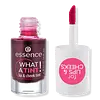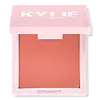What's inside
What's inside
 Key Ingredients
Key Ingredients

No key ingredients
 Benefits
Benefits

 Concerns
Concerns

 Ingredients Side-by-side
Ingredients Side-by-side

Water
Skin ConditioningGlycerin
HumectantPropanediol
SolventBetaine
Humectant1,2-Hexanediol
Skin ConditioningPanthenol
Skin ConditioningSodium Hyaluronate
HumectantLeuconostoc/Radish Root Ferment Filtrate
AntimicrobialXanthan Gum
EmulsifyingVaccinium Macrocarpon Fruit Extract
AstringentEthylhexylglycerin
Skin ConditioningLactic Acid
BufferingSodium Hydroxide
BufferingCitric Acid
BufferingPhenoxyethanol
PreservativeParfum
MaskingCI 16035
Cosmetic ColorantCI 42090
Cosmetic ColorantCI 45410
Cosmetic ColorantMica
Cosmetic ColorantZinc Stearate
Cosmetic ColorantSqualane
EmollientPerlite
AbsorbentCaprylyl Glycol
EmollientEthylhexylglycerin
Skin ConditioningCaprylic/Capric Triglyceride
MaskingRosa Hybrid Flower Extract
Skin ConditioningCI 77891
Cosmetic ColorantIron Oxides
CI 77163
Cosmetic ColorantCI 77007
Cosmetic ColorantCI 15850
Cosmetic ColorantCI 45410
Cosmetic ColorantCI 73360
Cosmetic ColorantCI 19140
Cosmetic Colorant
 Reviews
Reviews

Ingredients Explained
These ingredients are found in both products.
Ingredients higher up in an ingredient list are typically present in a larger amount.
CI 45410 is a synthetic red-pigment and dye.
It often goes by both Red 28 or Red 27; manufacturers label both ingredients as CI 45410.
This dye is commonly found in makeup because it imparts a vivid color. Some types of this dye change color based on pH level and interaction with moisture:
Your skin has a natural pH of around 4.5 - 5.5.
According to the FDA, CI 45410 is not permitted for use in eye products.
Red 27 is a flourescein dye and commonly used as a fluorescent tracer in medicine.
Learn more about CI 45410Ethylhexylglycerin (we can't pronounce this either) is commonly used as a preservative and skin softener. It is derived from glyceryl.
You might see Ethylhexylglycerin often paired with other preservatives such as phenoxyethanol. Ethylhexylglycerin has been found to increase the effectiveness of these other preservatives.